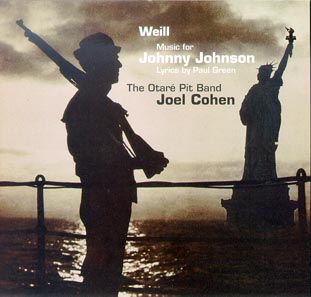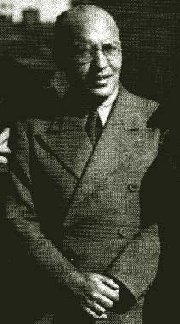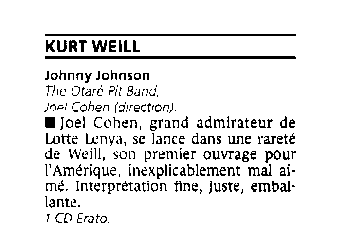Home | About The Camerata | Latest News | Recordings | Musician Biographies
Tours | Greater Boston Concert Series | Summer Workshop in Provence
Kurt Weill's Johnny Johnson
with Joel Cohen and the Otaré Pit Band
Erato CD (0630-17870-2)
Reissued by Warner Classics as Elatus CD 2564 61359-2
 |
THE BOSTON CAMERATA
JOEL COHEN, director
Johnny Johnson
music by Kurt Weill (1900-1950)
lyrics by Paul Green (1894-1981)
THE CAST (In order of appearance)
His Honor, the Major: Rene de la Garza
Minny Belle Tompkins the sweetheart of Johnny Johnson: Ellen Santaniello
Grandpa Joe, her grandfather: John Delorey
Johnny Johnson, a tombstone cutter and private citizen: Donald Wilkinson
Aggie Tomkins, Minny Belle's mother: Lynn Torgove
Westpointer: Mark MacSweeney
Captain Valentine, a U.S. army officer and formerly a movie stand-in: Richard Lalli
The Goddess: D'Anna Fortunato
An English Sergeant: Bruce Fithian
Private Harwood, a Texas cowpuncher: René de la Garza
A French nurse: Anne Azéma
An American Priest: Bruce Fithian
A German Priest: Richard Lalli
Doctor Mahodan, A psychiatrist: Paul Guttry
Villagers, West Point Cadets, Wounded Frenchmen, Allied Soldiers, Cannons, Laughing Generals, Inmates of the Forensic Society in a House of Balm: all of the above, as well as Margaret Swanson, Jean Danton, Elizabeth Anker, Megan Henderson, John Fleagle, Paul Cummings, Stephen Falbel.
THE OTARÉ PIT BAND Joseph Foley, Dana Oakes trumpet; Robert Couture trombone; Katherine Matasy clarinets, accordion; Diane Heffner saxophones, clarinet; Robert Mealy, Mimi Rabson violin; Reinmar Seidler cello; Robert Paul Sullivan guitar, banjo; Jeffrey Fischer percussion; Terry Halco Hammond organ, piano; Megan Henderson piano
ACT I
1. Introduction: The Otaré Pit Band/ 2. Over in Europe: René de la Garza and chorus/ 3. Democracy's call: René de la Garza, Ellen Santaniello, and chorus/ 4. The Battle of San Juan Hill: John Delorey and chorus/ 5. Johnny's song: Don ald Wilkinson/ 6. Aggie's Song: Lynn Torgove/ 7. Come back to me: Ellen Santaniello/ 8. Farewell Goodbye: Ellen Santaniello/ 9. West Point Song: Mark McSweeney and male chorus/ 10. Sergeant's Chant: Mark McSweeney/ 11. Captain Valentine's Song: Richard Lalli / 12. Army Interlude: The Otaré Pit Band/ 13. Farewell Goodby Interlude: The Otaré Pit Band/ 14. Song of the Goddess: D'Anna Fortunato/ 15. Song of the Wounded Frenchmen: male chorus/ 16. The Tea Song: Bruce Fithian and male chorus/ 17. Oh the Rio Grande: René de la Garza / 18. Johnny's Dream: Ellen Santaniello/ 19. Song of the Guns: male chorus/ 20. Music of the Stricken Redeemer: The Otaré Pit Band (strings)
ACT II
21. Mon Ami, My Friend: Anne Azéma/ 22. The Allied High Command: Paul Cummings and male chorus/ 23. The Laughing Generals: male chorus/ 24. The Battle: The Otaré Pit Band/ 25. In Times of War and Tumults: Bruce Fithian, Richard Lalli & male chorus/ 26. In No Man's Land: The Otaré Pit Band/ 27. The Psychiatry Song: Paul Guttry / 28. Asylum Chorus: male chorus/ 29. A hymn to Peace: male chorus/ 30. Asylum Chorus (repeat): The Otaré Pit Band/ 31. Johnny's Song (Finale): Donald Wilkinson
Metamorphosis and Parody
in Kurt Weill's "Johnny Johnson"
by Joel Cohen
 The "high" arts in the disillusioned years following World War One were much given to irony, satire, sardonic play, and collage. And no musican showed greater aptitude for all these tricks and tendencies than Kurt Weill. Perhaps this is why the drama critic Eric Bentley once referred to Weill's music, quite unfairly, as "parasitic." The grain of truth in Bentley's characterisation is that Weill's creative juices often ran strongest when he was imitating or parodying a prexisting musical style or maniera. One might even speculate that he needed a mainiera to get started. In any case, Weill was uniquely gifted at turning the essential stylistic traits of a given genre or epoch into a means to make his own statment. Behind Weill's satirical, modernist mask, however, is often a core of deep emotivity and even, at times, sentimentality. As Paul Green said in an unpublished interview, with Rhoda Wynn, "All of his music had sort of the same timbre or idiom or quality...well, that was his style, just like a painter." The personal, tragic-within-comic aspect of Weill's music is what Paul Green remembered; this is what most gives it lasting value, and its ability to haunt our inner ear long after the curtain has fallen or the CD has been removed from its cradle.
The "high" arts in the disillusioned years following World War One were much given to irony, satire, sardonic play, and collage. And no musican showed greater aptitude for all these tricks and tendencies than Kurt Weill. Perhaps this is why the drama critic Eric Bentley once referred to Weill's music, quite unfairly, as "parasitic." The grain of truth in Bentley's characterisation is that Weill's creative juices often ran strongest when he was imitating or parodying a prexisting musical style or maniera. One might even speculate that he needed a mainiera to get started. In any case, Weill was uniquely gifted at turning the essential stylistic traits of a given genre or epoch into a means to make his own statment. Behind Weill's satirical, modernist mask, however, is often a core of deep emotivity and even, at times, sentimentality. As Paul Green said in an unpublished interview, with Rhoda Wynn, "All of his music had sort of the same timbre or idiom or quality...well, that was his style, just like a painter." The personal, tragic-within-comic aspect of Weill's music is what Paul Green remembered; this is what most gives it lasting value, and its ability to haunt our inner ear long after the curtain has fallen or the CD has been removed from its cradle.
Johnny Johnson, coming as it does at the Euro-American crossroads in Weill's career, is especially dense in allusion, musical metaphor, and self-borrowing. Yet the very diversity of these elements, far from fragmenting the score, contribute layers of richness and complexity that lift the music far above the "Broadway Show" genre. Like many important composers of the Renaissance, Kurt Weill used popular music and popular forms to create classical works of permanent value; Johnny Johnson is among the finest of these.
The following notes on individual numbers of Johnny Johnson are by no means intended as an exhaustive study of this rich (and still largely unpublished) score, but hopefully they will contribute a few supplementary insights into a major figure of twentieth-century music.
1. Introduction. Weill recycles a tune from one of his Berlin scores, Happy End (written in collaboration with Berthold Brecht and Elizabeth Hauptmann).
3. Democracy's Call. Echoes of American (and German) patriotic songs of the late nineteenth century).
4. Up Chick-a-munga hill. The instrumental passage leading up to the messenger's arrival recalls Rossini's overture to William Tell.
5. Johnny's melody. This is the first appearance of the tune Weill wanted the audience to remember most strongly. It is related to an important song from his Paris period, J'attends un navire, from Marie Galante. Is the French song the direct European source for the tune that Paul Green mentions below, in the note to number 32? In any case J'attends un navire had its own, later history, as a song of the French resistance movement during World War II.
6. Aggie's song. Aggie is Pirate Jenny from the Dreigroschenoper, many years older and by now resigned to her fate, the violent corners rounded off (in deference to American sensibilities? here we have the first small signs in Weill's American phase of an edulcoration process which, in the opinion of some, was to deprive Weill's later American scores of their cutting edge). Aggie-Jenny still dreams of escape from her repetitive, manual labor. The brilliantly-scored orchestral ostinato of Aggie's song ("like a sewing machine," writes Weill in the score) derives from the obsessive, whisk-broom motif at the beginning of Seerauber Jenny. The marvelous orchestral postlude is as important as the song itself.
7. Come back to me. Minny Belle sings a sentimental waltz in the style of Victorian parlor music. Weill had already mined this vein in the lovers' duet in Dreigroschenoper.
8. Farewell goodbye. Minny Belle's second song, cut from the original production and the published piano-vocal score, receives its first recorded performance here. A clever variation on the melodic cell (A-C-D) of the preceding waltz, Farewell Goodbye was very likely Weill's first venture into swing-music style. In a videotaped interview preserved at the Kurt Weill Archive, New York, Phoebe Brand, the original Minny Belle, discusses this piece. Ms. Brand felt this was the best tune in the original score, and according to her, the composer agreed.
9. The West Pointer Song. Intended for a scene that was eventually cut from Paul Green's play, this important song was relegated to the appendix of the Weill orchestral score and remains unpublished to this day. Many echoes can be heard here of Mahler and his Knaben Wunderhorn.
10. The Sergeant's Chant. Another incisive moment that was eliminated from the published piano-vocal score. The grumbling baritone saxophone recalls Charles Gounod's Marche funèbre d'une marionette.
11. Captain Valentine's Song. A charming cad -- Rudolph Valentino-cum-Macheath -- sings this tango in an army recruiting office. Derived from one of the running jokes in Paul Green's script (the Captain keeps getting interrupted in his narration), our concert version seeks to present a continuous whole from the several fragments of this song that crop up at various points in the play (the published piano-vocal score is incomplete). Weill instructs the Hammond organ player to make his instrument sound "like an accordion;" in one of our very rare departures from the composer's original scoring, we use a real accordion in this number, and hope he would have approved.
12. Army Interlude. You can hear a quotation from "You're in the army now," alternating with an acidly satiric passage in Weill's Berlin style.
13. Farewell Goodbye. A long instrumental fantasy, previously unpublished and (except for the final passage) unrecorded; you will hear the Farewell Goodbye theme (varied as a marche militaire) and then Johnny's Melody, leading into one of the high points of Johnny Johnson,
14. Song of the Goddess. In this powerful piece, a goddess who does not exists sings of human folly. Traces of modal neo-medievalism in the song's first half are meant to evoke the antiquity of the stone from which she came; the second half derives from one of Weill's Paris chansons, Youkali, about a blessed place of truth and justice that, like the Goddess Liberty, does not exist.
15. Song of the Wounded Frenchmen. The piece begins as an Ouverture à la française; then there is more Mahlerian writing in the second part.
16. The Tea Song. An English music-hall turn.
17. Cowboy Song. Not a bad counterfeit of the real thing, coming from a recent German immigrant. Our soloist is, in real life, the son of a real cowboy.
18. Johnny's dream. Weill's orchestrations for the little pit band of Johnny Johnson are among the most varied and inventive of his entire ouevre. This brief, eerie variation of Come back to me employs wordless vocalise, Hawaian guitar slide effect, and Hammond organ to telling effect.
![]() 19. Song of the Guns. Tragic irony, Weill with his masks (almost) off, as the cannons that soon will kill sing a Germanic lullaby to the sleeping soldiers. There are echoes of the Schubert Serenade in the final soloist section.
19. Song of the Guns. Tragic irony, Weill with his masks (almost) off, as the cannons that soon will kill sing a Germanic lullaby to the sleeping soldiers. There are echoes of the Schubert Serenade in the final soloist section.
20. Music of the Stricken Redeemer. Christ's compassion for suffering Europe, and allusions to late-medieval music in the faux-bourdons near the end.
21. Mon Ami, my friend. A French cabaret turn, poignant and bittersweet, sung in the Green play by the nurse who cares for Johnny after he is wounded in action.
22. The Allied High Command. A sort of bloothirsty gavotte, intended to represent the decadence of Europe's ruling elites.
23. The Laughing Generals. A roaring-twenties Charleston puncuates this ballet towards the middle.
24. The Battle. Echoes of Stravinsky's L'Histoire du Soldat.
25. In times of war and tumults. One can suppose that the German text read and/or sung simultaneously with the English one was written by Weill himself. The melodic line (and the instrumental accompaniment) makes use of quasi-Gregorian chant formulas.
26. In no man's land. A reprise of the Mahlerian marche funebre from the "Song of the Wounded Frenchmen."
27. Johnny's Homecoming. Johnny's theme reprised, and then, like an atheist's Kaddish, the Youkali motif, as if to say: the war is over, there are many dead, and the war's ideals have come to naught.
28. The Psychiatry song. Each strophe of the song varies the musical style. The first recalls Duke Ellington's "Jungle music;" the second is meant to evoke, somehow or other, the Middle Ages; the third, American jazz. The melodic line recalls at one point the Tango from Dreigroschenoper.
29. Asylum chorus. "We had an old hymn down there in Harnett County that we sang, 'Blest Be the Tie that Binds,' and I sang it for Kurt and he would -- it would always go through his alchemy, through his psyche, and it would come out Kurt Weill's stuff" -- Paul Green, unpublished interview with Rhoda Wynn, 1974. "Blest be the Tie" becomes a neo-baroque siciliana; the guitarist is instructed to play "like a lute." (we have used a six string classical guitar, played finger-style rather than with plectrum).
30. A Hymn to Peace. Betsy Green Moyer, the playwrite's daughter, remembers that Paul Green, himself a noted folklorist, introduced Weill to traditional American folksong. This little canon certainly sounds like a modal folktune from the South.
32. Johnny's song. "Kurt Weill had told me earlier that he had written a melody in Europe...and he wanted to use it...it was a beautiful melody, but complicated...He said, 'If we can send the audience out humming a melody...it will be like a leitmotif, you know, that Wagner thing'...The thing to do is...to sum up the whole philosophy of this play into the musical statement at the end...Anyhow, Russell Collins who played the part of Johnny very well -- just as we come to the end of the play, he steps forward, passes out of the play...and makes his statement to the audience, and the orchestra drills it in, and then he wanders off whistling his melody. He's a defeated guy selling old toys in the street." -- Paul Green, unpublished interview with Rhoda Wynn, 1974.
These notes are (c) by Joel Cohen
Please click here to visit The Kurt Weill Foundation Home Page.
The Press Weighs In...


- Best of the year; "A major rediscovery" The Boston Globe, 12/97
- Diapason d'Or; "A surprising mix of caustic irony and emotion, directly conveyed by the cutting-edge sonorities of the Otaré Pit Band directed by Joel Cohen, author of a genuine adaptation for the recording medium. Heaven knows that it's not easy to exist on the razor's edge, avoiding sentimental caricature on the one side, aggressivity on the other. Although it is not immediately evident, the task is a hard one for the singers as well. Nonetheless, they find the right tone as though it were second nature. Let's hope that, as it should be, a true public success will greet this important world première." -- Diapason (Paris), 12/97
- "As for the interpretation: a delight, this perfect showtime swing, almost inhuman in its professionalism. But there is more. Cohen and his team, with great skill, avoid the usual traps of Weill projects, excessive lyricism and excessive intellectualism. Their work is very meticulous (restoration of cuts in the score, use of a Hammond organ of the period), but none of this prevents us from enjoying the music or feeling their jubilatory enthusiasm. Vocally, the cast is very homogeneous...lurking behind a kind of self-spoofing, their work is not so entirely American as all that; I hear the immense force of European civilisation as well...They have chosen this tone of bantering clarity, of restless perfection..." Répertoire (Paris), 1/98
- Choc du Monde; "The result is very cohesive. Joel Cohen, who up until now has excelled in medieval... and American "roots' repertoires...shows himself to be a knowing performer...with a fantastic team of singers and instrumentalists. The Weillian eloquence, associating comic and tragic elements, is magnified by the conductor, who extracts the very essence of Johnny Johnson..."Le Monde (1/98)
- "Magical equilibrium...obtained by the almost cinematic montage...The talented medievalist Joel Cohen reveals, with zest, Johnny Johnson, in its original beauty, surrounded by excellent performers..." Les Inrockuptibles (Paris), 12/97

- "Donald Wilkinson is a clear-voiced, candid Johnny Johnson, and the numerous supporting roles are perfectly executed..." Opéra International (Paris), 1/98
- "One of the great events of the 1996 season was the performance at tbe Longy School of Kurt Weill's first score for the American theater,"Johnny Johnson," by the Boston Camerata, conducted by the Camerata's artistic director, Joel Cohen. That performance was the prelude to recording sessions at Pine Manor College that have resulted in this Erato CD, the most important new Weill recording in several years.... The performance is stylish and assured, which means it has the rough edges that it should; the playing of the Otare Pit Band is superb (bravo to trombonist Robert Couture). The singers are full of character and Donald Wilkinson is particularly natural and affecting in the title role. This recording places all of us further in debt to the inquisitive spirit and talents of Joel Cohen." -- Richard Dyer, The Boston Globe, 2/19/98
Please click here to return to the current recordings list.
Please click here to return to The Boston Camerata Home Page.
©2007 The Boston Camerata. Inc.